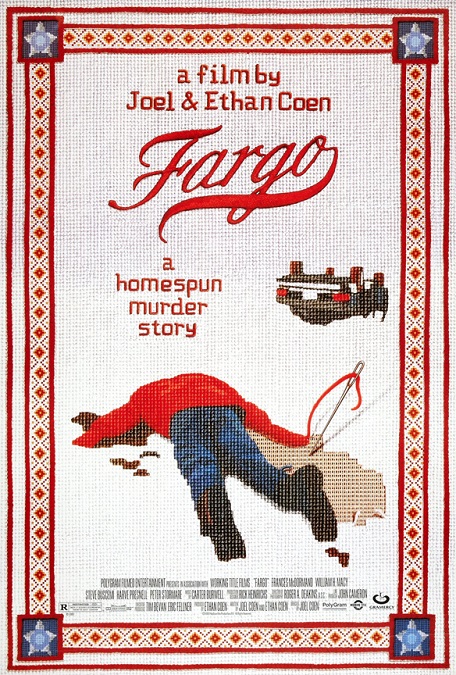
Fargo – 1996
I’d seen this movie before, but I had forgotten just how good it is, how perfectly the story was told. Joel and Ethan Coen were the masterminds behind the crime dramedy that took us from deadly serious to laugh-out-loud hilarious with a sense of ease and grace that surprised me. And the music had a lot to do with the film’s genius. Right from the very beginning of the opening credits, the score by Carter Burwell was soft and creepy like a baby nursery themed horror movie, but it worked.
It is hard to really determine who the film’s lead role was because it was really an ensemble cast. One might argue that Frances McDormand, playing the part of Brainerd Police Chief Marge Gunderson, was the lead, except that she doesn’t even show up on the screen until 33 minutes into the 98 minute movie. Add to that the fact that other members of the cast like William H. Macy, playing the part of Jerry Lundegaard, a desperate man who hires Carl Showalter and Gaear Grimsrud, played by Steve Buscemi and Peter Stormare to kidnap his wife so that they can demand a hefty ransom from her wealthy father, get just as much screen time as she does.
One fact about the movie that really caught my attention was that all three of the bad guys in the movie were incredibly stupid. They were profoundly over-the-top moronic, and yet they had just the right amount of realism in them. Somehow, they seemed perfectly believable, despite their unbelievable idiocy.
The worst of the lot was car salesman, Jerry. First, He floated a $320,000 GMAC loan to disguise his embezzlements from dealership bank accounts and collateralized it with nonexistent dealership vehicles. But he starts to panic when GMAC starts asking for VIN numbers. Then there is his hair-brained plot to have his wife kidnapped to extort money from her father, Wade Gustafson, played by Harve Presnell. Further still, there is a lucrative real-estate deal which Jerry brings to Wade. He expects Harve to give him $750,000 so that he can make the deal himself and reap its benefits, then pay back the initial principle. Harve and his accountant, Stan Grossman, played by Larry Brandenburg, laugh in his face and ask what they would get out of it. “We’re not a bank, Jerry.”
But everything starts to unravel when Carl and Gaear ineptly kidnap Jerry’s wife, Jean, played by Kristin Rudrüd. She is tied up and whimpering in the back seat of their car, when they are pulled over. Gaear ends up violently killing the police officer and two passing motorists who see Carl trying to dispose of the body. The movie is a black comedy and most of the humor really comes from the moronic antics of the three criminals.
It is at this point that Marge Gunderson is brought in. She is 7 months pregnant and is a wonderful character. She is calm in the face of both bloody murder victims and morning sickness. She can talk about picking up earth worms for her husband’s fishing trip as easily as she talks to two prostitutes who happily had sex with Carl and Gaear. And it is her easy and rational demeanor which really endears her to the viewer. In fact, McDormand’s performance was so likeable and well-played that she took home the Oscar for Best Actress. And strangely, another thing that people remember about the film, something that McDormand really got right, was the distinct regional Minnesota accent used by Marge, her fellow officers, and other locals. It is hard to describe, but completely unique.
By the end of the movie, Jean, Wade, and Carl get killed off, and Jerry goes on the run. Carl’s death is the most memorable, simply because of the flabbergasting way in which Gaear is caught trying to dispose of the body. He chops Carl up and is shoving the pieces into a wood chipper. Marge finds him and approaches him with her gun drawn. At first she cannot believe what she is seeing. There stands Gaear, shoving the leg into the chipper. Spattered blood covers the snow on the ground. Carl’s foot, with his sock still on, is still sticking up out of the machine. The look of calm shock on Marge’s face is perfect. Dark and disgusting? Without a doubt. But I had to laugh-out-loud at the scene’s absurdity.
But I also have to make mention of something that might confuse the movie a little. At the beginning of the movie, the following words appear on the screen: “THIS IS A TRUE STORY. The events depicted in this film took place in Minnesota in 1974. At the request of the survivors, the names have been changed. Out of respect for the dead, the rest has been told exactly as it occurred.” But according to the film’s directors, this is a complete lie. The events were completely fictional. But why did they try to convince us of the story’s authenticity? The Coen Brothers said, “The basic events are the same as in the real case, but the characterizations are fully imagined … If an audience believes that something’s based on a real event, it gives you permission to do things they might otherwise not accept.” But don’t worry. During the closing credits, they admit that it was all a work of fiction.








